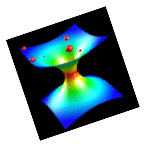Faculty Profile: Abhay Ashtekar
|
Abhay Ashtekar Director of IGC; 316 Whitmore Lab (physical address); 104 Davey Lab #171 (mailing address) University Park, PA 16802 Phone: +1 814-863-9605 Email: ashtekar@gravity.psu.edu |
 |
Research Interests: Loop Quantum Gravity, General Relativity, Cosmology, Gauge Theories, Generalizations of Quantum Mechanics, Geometry and Physics
In quantum gravity, my current research focuses on cosmology and black holes. Thanks to the contributions from dozens of researchers, loop quantum cosmology (LQC) has made significant advances over the last five years. The big-bang and the big-crunch singularities have been resolved in homogeneous models. As a result, LQC space-times are vastly larger than what Einstein had us believe. Details of Planck scale physics have also been worked out in these models. Recently, a framework was introduced to analyze cosmological perturbations using quantum fields in quantum space-times. The framework allows one to adequately handle perturbations whose seeds lie in the deep Planck regime, where matter densities and space-time curvature is some 11 orders of magnitude higher than that at the onset of standard inflation. We know that some of these seeds would not be washed away by the many e-foldings of inflation and can give rise, for example to non-Gaussianities. The question of whether such seeds are in fact produced during the big bounce, that replaces the big bang in LQC, is under active investigation.
Research on LQC has also provided important new insights into full loop quantum gravity (LQG). These include the emergence of a relational time variable, techniques to find the physical sector of the theory including the so-called ‘Dirac’ observables, concrete
support for the spin foam paradigm, insight into how entropy bounds can arise without a priori holographic input, and new physical effects – such as a brand new repulsive force – that emerge in the Planck regime from the specific quantum geometry that underlies LQG. There is considerable ongoing research on such issues to create a reliable bridge between LQG and LQC.

The fact that LQG can provide specific quantum extensions of classically singular space-times is also being used in black hole physics. Analysis is driven by conceptual issues, such as the quantum nature of the big-bang and the issue of information loss in Hawking evaporation, and uses advanced techniques at the interface of geometry, mathematical physics and computational science. Quantum geometry underlying LQG also accounts for black hole entropy. Here, the micro-states that feature in the statistical mechanical counting arise directly from the ‘atoms’ of the horizon quantum geometry, rather than from a hypothetical system of bosons and fermions that is ‘equivalent’ to a black hole. Furthermore, the calculation encompasses ‘isolated horizons’ which are more general than the event horizons of stationary black holes. In particular, cosmological horizons are naturally included.
In classical general relativity, I have been interested in the asymptotic structure of space-time, gravitational radiation theory, Lagrangian and Hamiltonian formulations without infinite counter-term subtractions and especially in the conceptual and physical understanding of dynamical black holes in the full, non-linear regime of general relativity. This last work in particular has a strong interface with numerical relativity where it provides tools to extract reliable physics from black hole simulations.
Further information: http://igc.psu.edu/people/Ashtekar/
